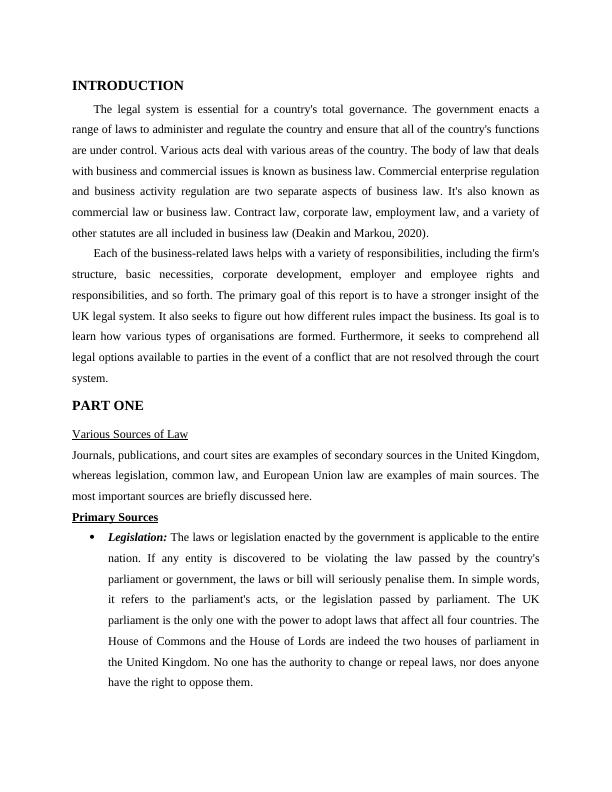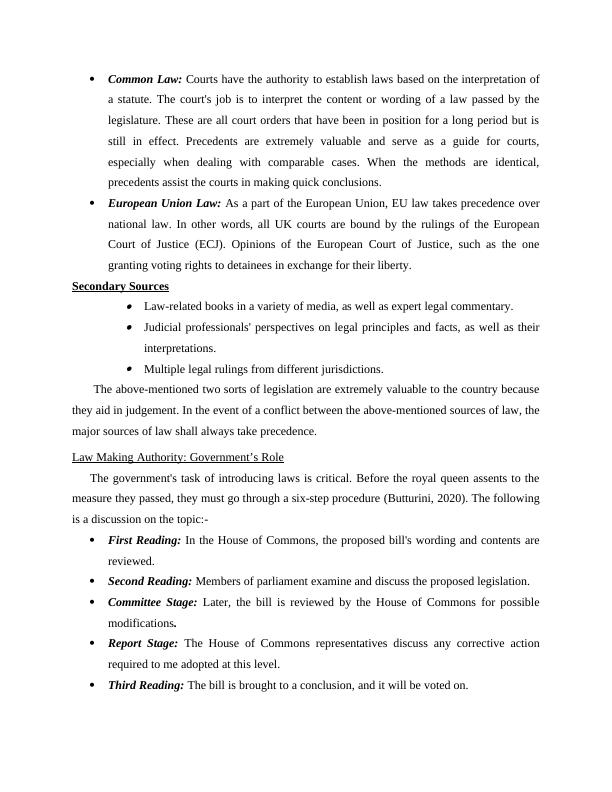7. Table of Contents INTRODUCTION......................
Added on 2022-11-25
12 Pages3739 Words2 Views
7

Table of Contents
INTRODUCTION...........................................................................................................................3
PART ONE......................................................................................................................................3
Various Sources of Law...............................................................................................................3
Law Making Authority: Government’s Role...............................................................................4
The Application of Statutory and Common Laws.......................................................................5
The Efficacy of English Legal System in view of Contemporary Advancements......................5
Impact of Business Legislation on Potential Businesses.............................................................5
Differentiate between Legislation, Standards and Regulations...................................................7
Types of Organizations along with their Formation, Management and Funding........................7
Advantages and Disadvantages of Business Organizations........................................................8
PART TWO:..................................................................................................................................10
Dispute Resolution.....................................................................................................................10
CONCLUSION..............................................................................................................................11
REFERENCES..............................................................................................................................12
INTRODUCTION...........................................................................................................................3
PART ONE......................................................................................................................................3
Various Sources of Law...............................................................................................................3
Law Making Authority: Government’s Role...............................................................................4
The Application of Statutory and Common Laws.......................................................................5
The Efficacy of English Legal System in view of Contemporary Advancements......................5
Impact of Business Legislation on Potential Businesses.............................................................5
Differentiate between Legislation, Standards and Regulations...................................................7
Types of Organizations along with their Formation, Management and Funding........................7
Advantages and Disadvantages of Business Organizations........................................................8
PART TWO:..................................................................................................................................10
Dispute Resolution.....................................................................................................................10
CONCLUSION..............................................................................................................................11
REFERENCES..............................................................................................................................12

INTRODUCTION
The legal system is essential for a country's total governance. The government enacts a
range of laws to administer and regulate the country and ensure that all of the country's functions
are under control. Various acts deal with various areas of the country. The body of law that deals
with business and commercial issues is known as business law. Commercial enterprise regulation
and business activity regulation are two separate aspects of business law. It's also known as
commercial law or business law. Contract law, corporate law, employment law, and a variety of
other statutes are all included in business law (Deakin and Markou, 2020).
Each of the business-related laws helps with a variety of responsibilities, including the firm's
structure, basic necessities, corporate development, employer and employee rights and
responsibilities, and so forth. The primary goal of this report is to have a stronger insight of the
UK legal system. It also seeks to figure out how different rules impact the business. Its goal is to
learn how various types of organisations are formed. Furthermore, it seeks to comprehend all
legal options available to parties in the event of a conflict that are not resolved through the court
system.
PART ONE
Various Sources of Law
Journals, publications, and court sites are examples of secondary sources in the United Kingdom,
whereas legislation, common law, and European Union law are examples of main sources. The
most important sources are briefly discussed here.
Primary Sources
Legislation: The laws or legislation enacted by the government is applicable to the entire
nation. If any entity is discovered to be violating the law passed by the country's
parliament or government, the laws or bill will seriously penalise them. In simple words,
it refers to the parliament's acts, or the legislation passed by parliament. The UK
parliament is the only one with the power to adopt laws that affect all four countries. The
House of Commons and the House of Lords are indeed the two houses of parliament in
the United Kingdom. No one has the authority to change or repeal laws, nor does anyone
have the right to oppose them.
The legal system is essential for a country's total governance. The government enacts a
range of laws to administer and regulate the country and ensure that all of the country's functions
are under control. Various acts deal with various areas of the country. The body of law that deals
with business and commercial issues is known as business law. Commercial enterprise regulation
and business activity regulation are two separate aspects of business law. It's also known as
commercial law or business law. Contract law, corporate law, employment law, and a variety of
other statutes are all included in business law (Deakin and Markou, 2020).
Each of the business-related laws helps with a variety of responsibilities, including the firm's
structure, basic necessities, corporate development, employer and employee rights and
responsibilities, and so forth. The primary goal of this report is to have a stronger insight of the
UK legal system. It also seeks to figure out how different rules impact the business. Its goal is to
learn how various types of organisations are formed. Furthermore, it seeks to comprehend all
legal options available to parties in the event of a conflict that are not resolved through the court
system.
PART ONE
Various Sources of Law
Journals, publications, and court sites are examples of secondary sources in the United Kingdom,
whereas legislation, common law, and European Union law are examples of main sources. The
most important sources are briefly discussed here.
Primary Sources
Legislation: The laws or legislation enacted by the government is applicable to the entire
nation. If any entity is discovered to be violating the law passed by the country's
parliament or government, the laws or bill will seriously penalise them. In simple words,
it refers to the parliament's acts, or the legislation passed by parliament. The UK
parliament is the only one with the power to adopt laws that affect all four countries. The
House of Commons and the House of Lords are indeed the two houses of parliament in
the United Kingdom. No one has the authority to change or repeal laws, nor does anyone
have the right to oppose them.

Common Law: Courts have the authority to establish laws based on the interpretation of
a statute. The court's job is to interpret the content or wording of a law passed by the
legislature. These are all court orders that have been in position for a long period but is
still in effect. Precedents are extremely valuable and serve as a guide for courts,
especially when dealing with comparable cases. When the methods are identical,
precedents assist the courts in making quick conclusions.
European Union Law: As a part of the European Union, EU law takes precedence over
national law. In other words, all UK courts are bound by the rulings of the European
Court of Justice (ECJ). Opinions of the European Court of Justice, such as the one
granting voting rights to detainees in exchange for their liberty.
Secondary Sources
Law-related books in a variety of media, as well as expert legal commentary.
Judicial professionals' perspectives on legal principles and facts, as well as their
interpretations.
Multiple legal rulings from different jurisdictions.
The above-mentioned two sorts of legislation are extremely valuable to the country because
they aid in judgement. In the event of a conflict between the above-mentioned sources of law, the
major sources of law shall always take precedence.
Law Making Authority: Government’s Role
The government's task of introducing laws is critical. Before the royal queen assents to the
measure they passed, they must go through a six-step procedure (Butturini, 2020). The following
is a discussion on the topic:-
First Reading: In the House of Commons, the proposed bill's wording and contents are
reviewed.
Second Reading: Members of parliament examine and discuss the proposed legislation.
Committee Stage: Later, the bill is reviewed by the House of Commons for possible
modifications.
Report Stage: The House of Commons representatives discuss any corrective action
required to me adopted at this level.
Third Reading: The bill is brought to a conclusion, and it will be voted on.
a statute. The court's job is to interpret the content or wording of a law passed by the
legislature. These are all court orders that have been in position for a long period but is
still in effect. Precedents are extremely valuable and serve as a guide for courts,
especially when dealing with comparable cases. When the methods are identical,
precedents assist the courts in making quick conclusions.
European Union Law: As a part of the European Union, EU law takes precedence over
national law. In other words, all UK courts are bound by the rulings of the European
Court of Justice (ECJ). Opinions of the European Court of Justice, such as the one
granting voting rights to detainees in exchange for their liberty.
Secondary Sources
Law-related books in a variety of media, as well as expert legal commentary.
Judicial professionals' perspectives on legal principles and facts, as well as their
interpretations.
Multiple legal rulings from different jurisdictions.
The above-mentioned two sorts of legislation are extremely valuable to the country because
they aid in judgement. In the event of a conflict between the above-mentioned sources of law, the
major sources of law shall always take precedence.
Law Making Authority: Government’s Role
The government's task of introducing laws is critical. Before the royal queen assents to the
measure they passed, they must go through a six-step procedure (Butturini, 2020). The following
is a discussion on the topic:-
First Reading: In the House of Commons, the proposed bill's wording and contents are
reviewed.
Second Reading: Members of parliament examine and discuss the proposed legislation.
Committee Stage: Later, the bill is reviewed by the House of Commons for possible
modifications.
Report Stage: The House of Commons representatives discuss any corrective action
required to me adopted at this level.
Third Reading: The bill is brought to a conclusion, and it will be voted on.

End of preview
Want to access all the pages? Upload your documents or become a member.
Related Documents
Business Law: Sources, Implications, and Managementlg...
|10
|3214
|448
Business Law: Legal Sources, Government Function, and Impact on Businesslg...
|8
|2160
|137
Introduction To Business Law (docs)lg...
|13
|3146
|249
Business Law: Sources, Role of Government, Contract Law, Company Law, Employment Laws, Legal Business Formationlg...
|11
|3657
|390
Business Law: Sources, Process, and Impact on Business Organizationslg...
|12
|3689
|51
English Legal System, Characteristics, Tort Law, Sources of Law, Nuisance and Contract Lawlg...
|8
|2728
|80